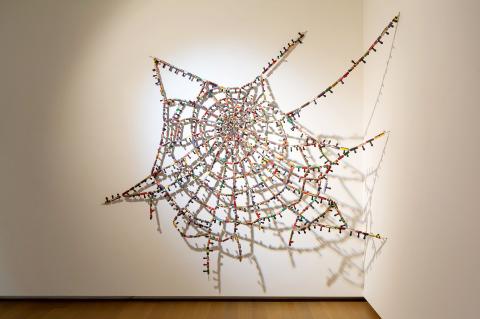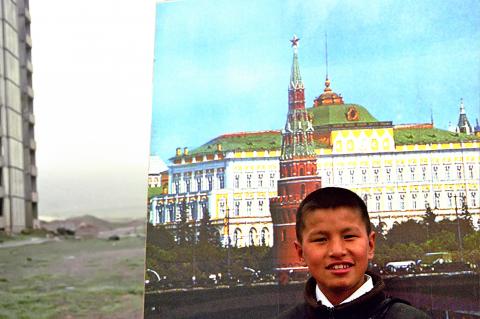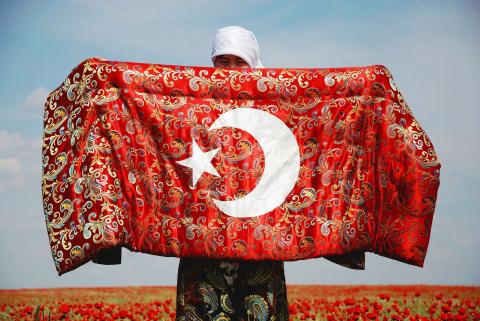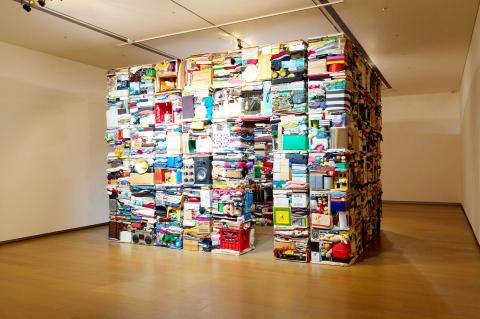In a recent opinion piece in Art+Auction titled Why Art Galleries Matter, Dorsey Waxter called on collectors and investors, flaneurs and aesthetes to forego biennials and art fairs and spend more time at local galleries as they are the engines that drive the whole art enterprise. It’s good sense.
With No-Mad-Ness in No Man’s Land, currently on view at Eslite Gallery (誠品畫廊), US-based curators Leeza Ahmady and Ombretta Agro Andurff have assembled an exceptionally clear-sighted group show notable for its thematic coherence and concise execution. Five years in the making from idea to execution, it counts as one of the best shows in Taipei this year.
The curatorial idea is nomadism, with all its broad contemporary connotations of movement, madness and marginalization, and cognate notions of migration, diaspora and borders. Ahmady and Andurff possess a delicate touch and approach the topic with detachment, intelligence and humor. Even when touching on potentially explosive issues, the show wears its politics lightly. And yet the exhibition — which includes 10 artists from eight countries, including Palestine, the Philippines, Uzbekistan, Lebanon, Afghanistan, India, Kazakhstan and Israel-Palestine — remains as much a cultural investigation of these under-represented countries as it is an aesthetic experience.

Photo courtesy of Eslite Gallery
Andruff told the Taipei Times that the chosen artists, many of whom have represented their countries at the Venice Biennale and Documenta, are “deeply rooted in their own culture but use recognized iconography that everyone can understand.” The employment of local imagery to speak in a global voice is the key to unlocking the entire show.
This is most clearly manifested in Yelena and Viktor Vorobyev’s Knife, a park bench-sized sculpture in the shape of a kitchen knife made from wood and stone. Seen on the gallery floor, it appears a throwaway emblem, large and inert. Its deceptive simplicity, however, is pregnant with associations: the hunt and the hearth, the secure and the violent, the domestic and the predatory, the masculine and the feminine. It is such a well-crafted tactile object that one is tempted to touch it, run a finger along its jagged blade. A tool of power, yet of domestication and, in our day — with its Michelin stars and plastic surgery — rarefied skill, the object evokes a tangent along which we can imagine the development of society from hunter-gatherer to the sedentary lifestyle found in today’s advanced countries.
Reena Saini Kallat works in a similar kind of duality, but here moves beyond nomadism into the realm of border crossings. In Untitled (Cobweb Knots and Crossings), Kallat, from India, affixes together hundreds of rubber stamps emblazoned with national flags to form the shape of a web. The object can be a trap, the individual entangled in bureaucratic network of officialdom, or a home.

Photo courtesy of Eslite Gallery
Borders and migration are themes picked up by Isabel and Alfredo Aquilizan, an Australia-based Filipino husband and wife. Their Address is a monumental installation in the shape and size of a roofless shack, assembled from 140 boxes that contain all manner of household objects — clothing, toys, board games, fans and computers — that the artists have accumulated over the years. It serves as a powerful symbol of the Filipino diaspora, the objects are memories a family gathers over a lifetime of movement.
There is much else to see here and though the theme might be broad, it is never derivative. Sharif Waked’s video of a donkey forced to undergo a shower to remove its zebra stripes in Bath Time, is an amusing statement about identities immigrants undergo and have to strip in a new land.
One gains the sense over the past few years that Taipei’s galleries are cluing in to the importance of reaching out to international artists and curators. Hopefully, exchanges will result from this. And what is remarkable here is that they are doing so while moderating the rarefied language that has become de rigeur of public museums. No-Mad-Ness in No Man’s Land is a fine example of how a commercial gallery can successfully work with international curators and artists. Let’s hope to see more of this in the future.

Photo courtesy of Eslite Gallery
■ No-Mad-Ness in No Man’s Land runs until Dec. 22 at Eslite Gallery (誠品畫廊), 5F, 11 Songgao Rd, Taipei City (台北市松高路11號5樓), tel: (02) 8789-3388 X1588. Open Tuesdays to Sundays from 11am to 7pm.

Photo courtesy of Eslite Gallery

Exceptions to the rule are sometimes revealing. For a brief few years, there was an emerging ideological split between the Democratic Progressive Party (DPP) and Chinese Nationalist Party (KMT) that appeared to be pushing the DPP in a direction that would be considered more liberal, and the KMT more conservative. In the previous column, “The KMT-DPP’s bureaucrat-led developmental state” (Dec. 11, page 12), we examined how Taiwan’s democratic system developed, and how both the two main parties largely accepted a similar consensus on how Taiwan should be run domestically and did not split along the left-right lines more familiar in

This month the government ordered a one-year block of Xiaohongshu (小紅書) or Rednote, a Chinese social media platform with more than 3 million users in Taiwan. The government pointed to widespread fraud activity on the platform, along with cybersecurity failures. Officials said that they had reached out to the company and asked it to change. However, they received no response. The pro-China parties, the Chinese Nationalist Party (KMT) and Taiwan People’s Party (TPP), immediately swung into action, denouncing the ban as an attack on free speech. This “free speech” claim was then echoed by the People’s Republic of China (PRC),

As I finally slid into the warm embrace of the hot, clifftop pool, it was a serene moment of reflection. The sound of the river reflected off the cave walls, the white of our camping lights reflected off the dark, shimmering surface of the water, and I reflected on how fortunate I was to be here. After all, the beautiful walk through narrow canyons that had brought us here had been inaccessible for five years — and will be again soon. The day had started at the Huisun Forest Area (惠蓀林場), at the end of Nantou County Route 80, north and east

Specialty sandwiches loaded with the contents of an entire charcuterie board, overflowing with sauces, creams and all manner of creative add-ons, is perhaps one of the biggest global food trends of this year. From London to New York, lines form down the block for mortadella, burrata, pistachio and more stuffed between slices of fresh sourdough, rye or focaccia. To try the trend in Taipei, Munchies Mafia is for sure the spot — could this be the best sandwich in town? Carlos from Spain and Sergio from Mexico opened this spot just seven months ago. The two met working in the